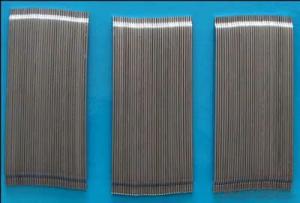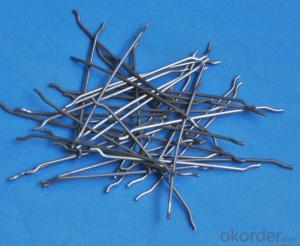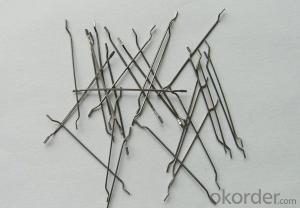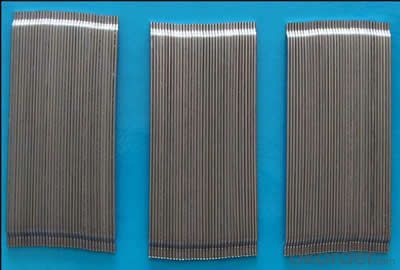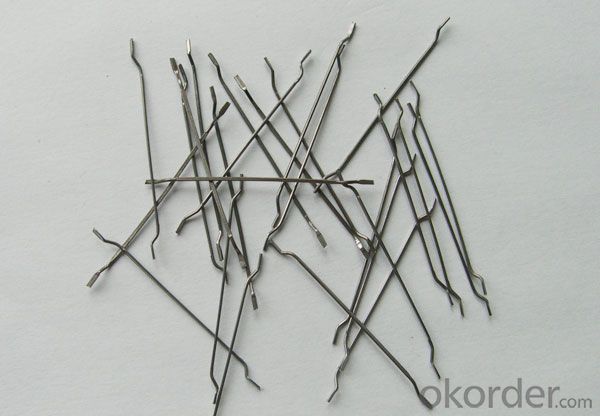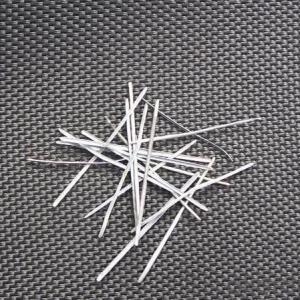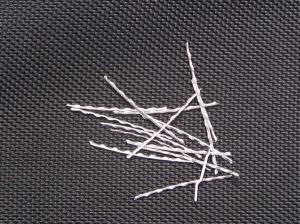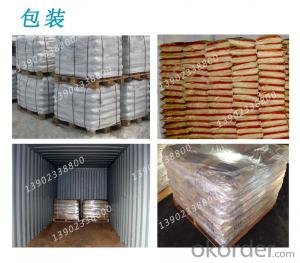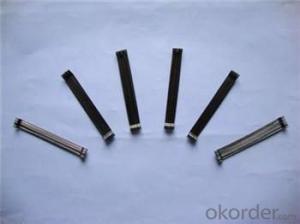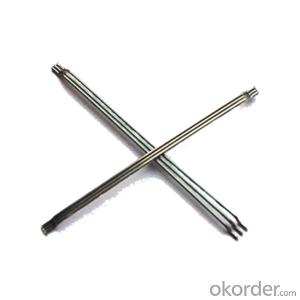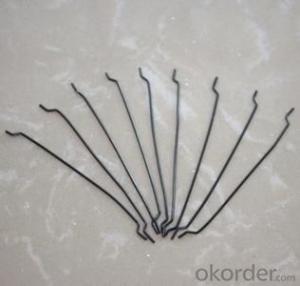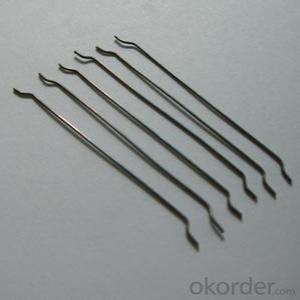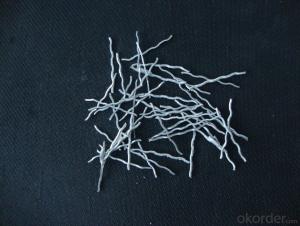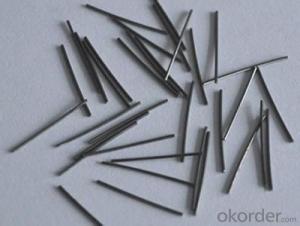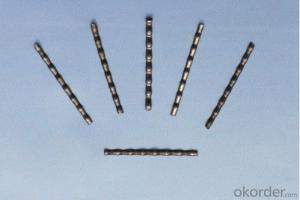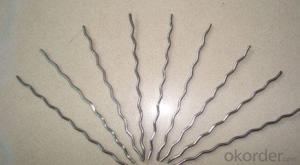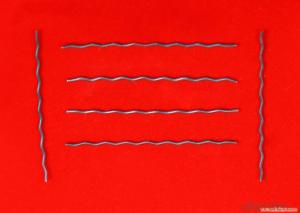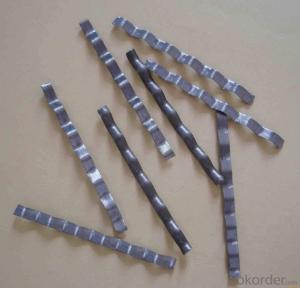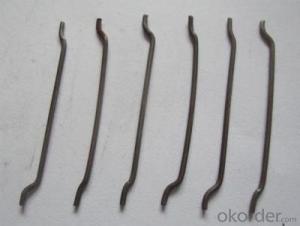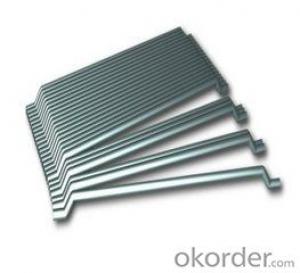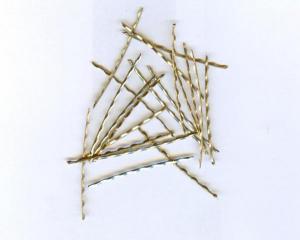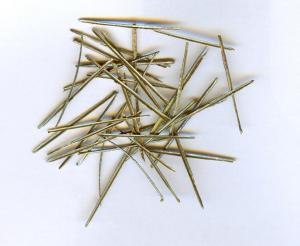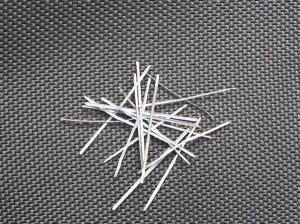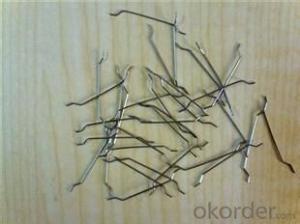Melt Extract Stainless Steel Fiber Reinforced Concrete Admixtures
- Loading Port:
- Tianjin
- Payment Terms:
- TT OR LC
- Min Order Qty:
- 1000 kg
- Supply Capability:
- 250000 kg/month
OKorder Service Pledge
OKorder Financial Service
You Might Also Like
Quick Details
Place of Origin: Shandong, China (Mainland)
Model Number: steel fiber
material: steel wire
application: concrete reinocement
type: end hook steel fiber
Product features
with excellent tensile ,hightenacity ,against cracking and fatigue ,they`re widely usd in the structures made of concrete
Specifications
1.hooked steel fiber
2.CE and ISO9001:2008
3.diameter from 0.5mm to 1.2mm
4.competitive price,high quality and service
Hooked Steel Fiber:
1.Diameter:0.5mm-1.0mm
2.Length: 25mm-60mm
3.Material: low carbon steel wire
4.Feature: excellent tensile,high tenacity,against cracking,impact and fatigue
5.Uses: high way,tunnel,building,airport road serface and so on .
Picture

steel fiber concrete reinforced
1.hooked steel fiber
2.CE and ISO9001:2008
3.diameter from 0.5mm to 1.2mm
4.competitive price,high quality and service
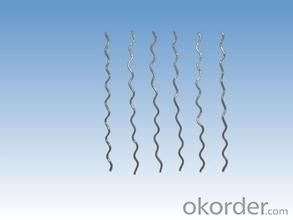
FAQ
we can produce any type steel fiber and of course we can make production according to your requirement
we have specilize in this field for almost 10 years ,with good quality and competitive price
- Q: Can melt extract stainless steel fiber be used in airport runway pavements?
- Yes, melt extract stainless steel fiber can be used in airport runway pavements. Stainless steel fibers are commonly used in concrete mixtures to enhance the mechanical properties and durability of the material. They can improve the resistance to cracking, impact, and fatigue, which are crucial factors in airport runway pavements. The use of stainless steel fibers can help increase the lifespan of the pavement by reducing the potential for cracking and deterioration caused by heavy aircraft loads and constant traffic. Additionally, stainless steel fibers can enhance the overall strength and load-bearing capacity of the pavement, making it suitable for the demanding conditions of airport runways.
- Q: How does melt extract stainless steel fiber affect the shrinkage and creep of concrete?
- Melt extract stainless steel fiber has a positive impact on both shrinkage and creep of concrete. The addition of these fibers helps to reduce the overall shrinkage of concrete, resulting in less cracking and improved durability. Additionally, these fibers enhance the resistance to creep, which is the deformation that occurs over time under sustained load. By mitigating shrinkage and creep, melt extract stainless steel fiber contributes to the enhanced performance and longevity of concrete structures.
- Q: What is the recommended mix design for concrete containing melt extract stainless steel fiber?
- The recommended mix design for concrete containing melt extract stainless steel fiber typically involves using a higher dosage of fibers compared to traditional concrete mix designs. This is because stainless steel fibers have a higher aspect ratio and better tensile strength, which allows for better reinforcement and crack resistance in the concrete. The fiber dosage can vary depending on the specific application and desired performance characteristics of the concrete. However, a general guideline is to use between 1% to 2% by volume of stainless steel fibers. This dosage range has been found to provide optimal reinforcement and improve the overall durability of the concrete. In addition to the fiber dosage, it is important to consider other factors such as the water-cement ratio, aggregate gradation, and admixture selection. The water-cement ratio should be carefully controlled to ensure the mix is workable and has adequate strength. The aggregate gradation should be optimized to provide a dense and strong concrete matrix. Admixtures can also be used to improve the workability, pumpability, and setting time of the concrete. It is recommended to consult with a qualified engineer or concrete supplier to determine the specific mix design parameters for a project involving melt extract stainless steel fiber. Overall, the recommended mix design for concrete containing melt extract stainless steel fiber involves a higher fiber dosage, careful control of water-cement ratio, optimization of aggregate gradation, and appropriate use of admixtures. This will help ensure a high-performance concrete with improved reinforcement and durability properties.
- Q: How does melt extract stainless steel fiber affect the carbonation resistance of concrete?
- The addition of melt extract stainless steel fiber can greatly improve the resistance of concrete to carbonation. Carbonation is a chemical process in which carbon dioxide from the atmosphere reacts with the calcium hydroxide in concrete, forming calcium carbonate. This process can decrease the alkalinity of the concrete, leading to corrosion of embedded reinforcement and a decrease in the overall durability of the structure. When melt extract stainless steel fiber is incorporated into concrete, it forms a three-dimensional reinforcement network, which enhances both the mechanical properties and durability of the concrete. These stainless steel fibers act as a physical barrier, reducing the entry of carbon dioxide into the concrete matrix. This barrier effect slows down the carbonation process, effectively increasing the concrete's resistance to carbonation. Moreover, the stainless steel fibers also improve the mechanical properties of the concrete, making it more resistant to cracking and spalling. This increased resistance to cracking further reduces the potential for carbon dioxide to penetrate the concrete, as cracks serve as pathways for gas diffusion. Additionally, the stainless steel fibers provide an extra layer of corrosion protection to the embedded reinforcement, helping to mitigate the effects of carbonation. The fibers function as sacrificial anodes, redirecting any potential corrosion initiation sites away from the reinforcement and onto themselves. This sacrificial anode effect prolongs the service life of the concrete structure by reducing the risk of reinforcement corrosion caused by carbonation. In conclusion, the melt extract stainless steel fiber has a positive impact on the carbonation resistance of concrete by acting as a physical barrier, enhancing mechanical properties, and providing additional corrosion protection to the embedded reinforcement. These advantages contribute to increased durability and extended service life of concrete structures in environments prone to carbonation.
- Q: Can melt extract stainless steel fiber be used in precast bridge elements?
- Yes, melt extract stainless steel fiber can be used in precast bridge elements. Melt extract stainless steel fibers are known for their high tensile strength, corrosion resistance, and durability, making them suitable for use in various construction applications, including precast bridge elements. These fibers can enhance the mechanical properties of concrete, such as its flexural strength and crack resistance, thereby improving the overall performance and lifespan of the bridge elements. Additionally, the use of stainless steel fibers can also reduce the need for traditional reinforcement, leading to cost savings and faster construction. However, it is important to ensure that the fiber dosage and distribution are properly controlled during the precast fabrication process to achieve optimal performance and structural integrity.
- Q: What is the lifespan of melt extract stainless steel fiber in concrete?
- The durability and lifespan of melt extract stainless steel fiber in concrete can vary due to several factors, including fiber quality, application, and environmental conditions. Generally, melt extract stainless steel fibers are known for their long lifespan and resistance to corrosion. Under normal concrete conditions, the lifespan of melt extract stainless steel fiber can range from 20 to 50 years. This is possible because stainless steel has high tensile strength and corrosion resistance, enabling it to withstand harsh concrete conditions such as moisture, chemicals, and temperature changes. However, it's important to consider that the lifespan can be influenced by factors like fiber quality, concrete mix design, and the maintenance of the concrete structure. Proper installation, curing methods, regular maintenance, and inspections can significantly prolong the lifespan of stainless steel fiber in concrete. Additionally, the specific application of the concrete, such as heavy traffic areas or exposure to extreme weather conditions, can impact the lifespan of the stainless steel fiber. In such cases, applying surface coatings or sealants may be necessary to further protect the stainless steel fiber and enhance its longevity. Overall, melt extract stainless steel fiber is a reliable and durable reinforcement material for concrete structures. With proper care and maintenance, it can provide a lifespan of 20 to 50 years or even longer.
- Q: Can melt extract stainless steel fiber be used in water treatment plant construction?
- Yes, melt extract stainless steel fiber can be used in water treatment plant construction. It is commonly used in this industry due to its corrosion resistance, durability, and ability to withstand high temperatures and chemical exposure.
- Q: What is the recommended mix design when using melt extract stainless steel fiber in concrete?
- The recommended mix design when using melt extract stainless steel fiber in concrete typically involves a dosage rate of 1 to 2% by volume of concrete. This dosage rate helps to enhance the mechanical properties of the concrete, such as its tensile strength, flexural strength, and impact resistance. Additionally, it is important to use a well-graded aggregate and a water-cement ratio that is suitable for the specific application and desired performance requirements.
- Q: Can melt extract stainless steel fiber be added to cementitious grouts?
- It is possible to incorporate melt extract stainless steel fiber into cementitious grouts. These fibers are often utilized as a reinforcement material in cementitious products to boost their mechanical properties. By introducing stainless steel fibers into grouts, one can enhance their tensile strength, flexural strength, and resistance to cracks. Furthermore, the inclusion of stainless steel fibers aids in managing shrinkage and preventing cracking. All in all, the integration of melt extract stainless steel fibers into cementitious grouts can elevate their effectiveness and longevity.
- Q: How does the addition of melt extract stainless steel fiber affect the fresh concrete properties?
- The fresh concrete properties can be significantly improved by incorporating melt extract stainless steel fiber. To start with, the presence of stainless steel fibers acts as reinforcement within the concrete matrix, thereby enhancing its overall strength and durability. These fibers work to evenly distribute the load throughout the concrete, minimizing the risk of cracking and enhancing its resistance to impact and abrasion. Furthermore, the workability of the fresh concrete is also improved by the stainless steel fibers. They function as a lubricant, facilitating the smooth flow of the concrete during placement and compaction. This aids in achieving better consolidation and eliminates any voids, resulting in a denser and more uniform concrete structure. In addition, the inclusion of stainless steel fibers enhances the cohesion and cohesiveness of the fresh concrete, reducing the chances of segregation and bleeding. This is particularly advantageous in applications where the concrete needs to be pumped or placed in vertical or overhead positions. Moreover, the stainless steel fibers play a crucial role in controlling shrinkage and cracking in the fresh concrete. By providing a reinforcement network, these fibers restrict the tensile forces that occur during drying and curing, thereby minimizing crack development and improving the dimensional stability of the concrete as a whole. To summarize, the addition of melt extract stainless steel fiber not only improves the strength and durability of fresh concrete but also enhances its workability, cohesiveness, and resistance to shrinkage and cracking. This makes it an excellent choice for various applications such as industrial floors, pavements, precast elements, and shotcrete, where high-performance concrete properties are desired.
Send your message to us
Melt Extract Stainless Steel Fiber Reinforced Concrete Admixtures
- Loading Port:
- Tianjin
- Payment Terms:
- TT OR LC
- Min Order Qty:
- 1000 kg
- Supply Capability:
- 250000 kg/month
OKorder Service Pledge
OKorder Financial Service
Similar products
Hot products
Hot Searches
Related keywords
